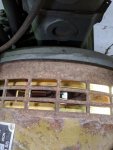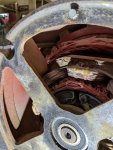76shovel
Member
- 69
- 10
- 8
- Location
- Bunnell/FL
I have an 803a and doing a motor swap. For the life of me I can't find in the manuals anywhere on how to remove the gen set from the engine adapter plate.
I have through studs from the rear of the gen set to the adapter plate and fastens securely there and have bolts on the flywheel but not accessible through the vent louvers of the housing or cooling fins of the flywheel
Can anyone offer some advice or point me to the right manual
I have some pics of the bolt head and a pic of one of the through studs...surely this thing don't have to come apart to separate them
Thanks for any help


I have through studs from the rear of the gen set to the adapter plate and fastens securely there and have bolts on the flywheel but not accessible through the vent louvers of the housing or cooling fins of the flywheel
Can anyone offer some advice or point me to the right manual
I have some pics of the bolt head and a pic of one of the through studs...surely this thing don't have to come apart to separate them
Thanks for any help




